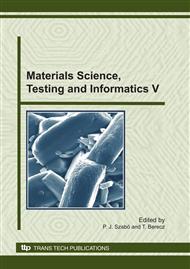[1]
H. G. Nelson: Treatise on Materials Science and Technology, Academic Press, New York, 1983, Vol. 25, p.275.
Google Scholar
[2]
N. Eliaz, A. Shachar, B. Tal., D. Eliezer: Engineering Failure Analysis 9, 2002, p.167.
Google Scholar
[3]
R. A. Oriani, J. P. Hirth, and M. Smialowski: Hydrogen Degradation of Ferrous Alloys (Noyes Publications, Park Ridge, NJ, (1985).
DOI: 10.1557/s0883769400069670
Google Scholar
[4]
Pressouyre, G. M., Bernstein I.: M. Met . Trans. 1981A 12A(5): 835-844.
Google Scholar
[5]
J. C. J. McMahon: Innovations in Ultrahigh-Strength Steels, Proceedings of the 34th Sagamore Army Materials Research Conference, Washington, DC, 1990, p.597.
Google Scholar
[6]
H. J. Grabke, E. Riecke: Mater. Technol. 34, 331 (2000).
Google Scholar
[7]
A. San-Martin and F. D. Manchester, Phase Diagrams of Binary Iron Alloys, edited by H. Okamoto (ASM International, Materials Park, OH, 1993), p.161.
Google Scholar
[8]
Industrial standard MSzEN 10209: (2000).
Google Scholar
[9]
E.R. Fábián, B. Verő: XXI. International Enamellers Congress, 2008, pp.294-304.
Google Scholar
[10]
K. Kiuchi , R. B Mc Lellan: Perspectives of Hydrogen in Metals, Pergamon Press; 1990, 49.
Google Scholar
[11]
D. E. Jiang and Emily A. Carter: Phisical Review B, 70, 2004, 064102-5.
Google Scholar
[12]
J.I. Verdeja, J. Asensio, and J.A. Pero-Sanz: Mater. Charact., 2003, vol. 50, pp.81-86.
Google Scholar
[13]
T. Ungár, J. Gubicza, P. Hanák, I. Alexandrov: Mat. Sci. and Eng. A319-321 (2001) 274-278.
Google Scholar
[14]
E. R. Fábián, L. Dévényi: Materials Science, Testing and Informatics; 2006 pp.33-40.
Google Scholar
[15]
B. Marandet: Stress Corrosion Cracking and Hydrogen Embrittlement of Iron Base Alloys (ed. R.W. Staehle et al) National Association of Corrosion Engineers, Houston, 1977, pp.775-787.
Google Scholar
[16]
H. Huang and W.J.D.: Shaw Corrosion Science, Vol. 51, 1995, No. 1, p.32.
Google Scholar
[17]
A. J. Kumnick and H. H. Johnson: Acta Met. Vol. 28, 1980 p.33.
Google Scholar
[18]
M. Martinez-Madrid, S.L. I Chan, J.A. Charles: Mat. Sci. and Tech., VI., 1985/p.459.
Google Scholar


